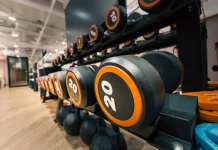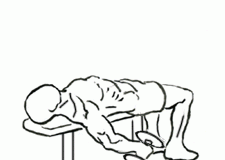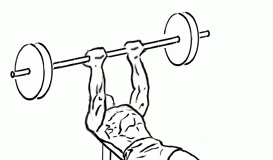Last Updated on November 8, 2024
The Reverse Grip Triceps Pushdown is a highly effective exercise targeting the triceps, specifically the long head of the muscle. By reversing your grip—palms facing up instead of down—you engage different muscle fibers, leading to greater muscle activation in the triceps. This subtle change also activates your forearms and stabilizes your shoulder joints, making it an essential addition to any upper body workout.
Benefits of the Reverse Grip Triceps Pushdown
- Triceps Isolation: The exercise primarily targets the triceps, particularly the long head, which runs along the back of your upper arm. This area is often undertrained, so the reverse grip is especially useful for achieving balanced tricep development.
- Enhanced Muscle Activation: By using a reverse grip, you encourage muscle fibers in the triceps to work differently, leading to more balanced strength and muscular development.
- Forearm and Grip Strength: Holding the bar with a reverse grip increases forearm engagement and improves grip strength. This additional activation helps improve performance in other exercises, like deadlifts and pull-ups.
- Shoulder Stability: This exercise provides shoulder joint stability as your elbows remain close to your torso, reducing unnecessary strain on the shoulder.
- Aesthetics: Building well-rounded triceps enhances arm appearance and helps create the overall shape of the arm, especially for those working towards aesthetic goals.
Step-by-Step Guide: How to Perform the Reverse Grip Triceps Pushdown
To get the most out of this exercise, let’s break it down into a series of steps.
1. Setting Up the Equipment
- Cable Machine: Find a cable machine at your gym with a high pulley setup. You’ll need a straight or EZ bar attachment, as both are suitable for the reverse grip.
- Weight Selection: Start with a lighter weight to focus on your form before increasing. This exercise should prioritize controlled movement over heavy lifting to avoid injury.
2. Starting Position
- Grip: Stand close to the cable machine and grab the bar attachment with an underhand grip, meaning your palms are facing up (supinated grip).
- Hand Placement: Your hands should be shoulder-width apart or slightly closer, depending on comfort and personal range of motion.
- Stance: Stand with one foot slightly in front of the other. This stance provides a stable base and reduces the chance of leaning or swaying during the movement.
- Posture: Stand upright with a slight bend in your knees. Keep your shoulders relaxed and your chest up, maintaining a strong posture throughout.
- Elbow Position: Your elbows should be close to your torso and remain stationary throughout the exercise. This positioning isolates the triceps, ensuring they bear the load rather than other muscles compensating.
3. Executing the Movement
- Push Down: Begin by pulling the bar down, keeping your elbows close to your sides. Focus on using only your triceps to extend your arms downward.
- Range of Motion: Extend until your arms are nearly straight but avoid locking out your elbows. A slight bend at the bottom reduces strain on the joints and keeps tension in the triceps.
- Pause: Hold the bottom position for a moment to maximize muscle activation. This pause also reduces the chance of letting momentum take over.
- Controlled Release: Slowly return to the starting position, allowing your forearms to rise in a controlled manner without losing tension in your triceps.
4. Breathing Technique
- Inhale as you bring the bar back up to the starting position.
- Exhale during the downward push, engaging your core to maintain stability.
Common Mistakes to Avoid
Even small errors in form can hinder your progress or lead to discomfort. Here are common mistakes and tips to correct them:
- Using Momentum: Avoid swinging or jerking the weight down. Use a controlled, steady motion to engage your triceps fully.
- Leaning Forward or Backward: Keep your body upright and avoid leaning into or away from the machine. Proper posture helps isolate the triceps.
- Elbows Flaring Out: The elbows should remain close to your torso. If they flare out, it reduces triceps engagement and puts stress on the shoulders.
- Not Controlling the Release: Letting the bar “snap” back up can be tempting, especially when lifting heavier weights. However, this reduces tension in the triceps and increases the chance of elbow strain. Control the upward phase just as much as the pushdown.
- Too Much Weight: Overloading compromises your form and increases injury risk. Start with a manageable weight and progress gradually as your triceps get stronger.
Tips for Maximizing the Exercise
- Mind-Muscle Connection: Focus on feeling the triceps working throughout the movement. This technique improves activation and results over time.
- Use of Wrist Straps: If you find grip strength limiting, consider using wrist straps to maintain a firm hold on the bar.
- Tempo Variation: Occasionally try slowing down each phase of the movement to increase time under tension and encourage muscle growth.
- Superset with Regular Pushdowns: For an added challenge, you can combine reverse grip pushdowns with regular triceps pushdowns to exhaust the triceps completely.
Muscle Anatomy and Focus
Understanding the triceps’ structure will help you perform the exercise more effectively. The triceps brachii is composed of three heads:
- Long Head: Located along the back of your arm, this head is especially engaged during the reverse grip due to the unique angle.
- Lateral Head: Positioned on the outer side of the triceps, it’s activated more during exercises with a neutral or overhand grip.
- Medial Head: Situated underneath the other two heads, it works as a stabilizer and gets indirect activation.
The reverse grip primarily targets the long head, making it a great choice for those seeking complete tricep development. This head contributes to overall arm mass, especially when viewed from the back.
Incorporating the Exercise into Your Workout Routine
The Reverse Grip Triceps Pushdown can be performed within a triceps-focused workout or an upper body session. Here are a few ways to incorporate it:
Sample Tricep Workout
- Close-Grip Bench Press: 3 sets of 8-10 reps
- Overhead Triceps Extension: 3 sets of 10-12 reps
- Reverse Grip Triceps Pushdown: 3 sets of 12-15 reps
- Dips: 3 sets of 8-10 reps
Sample Upper Body Workout
- Bench Press: 4 sets of 6-8 reps
- Rows: 4 sets of 8-10 reps
- Overhead Shoulder Press: 3 sets of 8-10 reps
- Reverse Grip Triceps Pushdown: 3 sets of 12-15 reps
Aim to do this exercise toward the end of your triceps workout to fully fatigue the muscles after compound movements.
Variations of the Reverse Grip Triceps Pushdown
- Single-Arm Reverse Pushdown: Attach a single handle and perform the exercise one arm at a time for better control and isolation.
- Rope Pushdown with Reverse Grip: Use a rope attachment instead of a bar. This variation allows for a greater range of motion and enhances the mind-muscle connection with the triceps.
- Kneeling Reverse Pushdown: Perform the exercise in a kneeling position. This variation can help improve focus and stability, particularly if you struggle with upper body sway.
- Resistance Band Reverse Pushdown: If you don’t have access to a cable machine, you can replicate the movement using resistance bands. Anchor the band to a high point and proceed with the same movement.
Frequently Asked Questions
Is the Reverse Grip Triceps Pushdown Safe?
Yes, this exercise is generally safe if performed with the correct form. The reverse grip puts less strain on the elbows compared to an overhand grip. However, be sure to avoid excessive weights, as this can place unnecessary strain on your wrists.
What Weight Should I Start With?
Beginners should start light and focus on form before adding weight. Starting around 10-20 pounds is reasonable, with the option to increase gradually.
Should I Use an EZ Bar or Straight Bar?
Both bars are effective. The EZ bar is slightly more ergonomic and can reduce wrist strain, while the straight bar may provide a more direct grip for targeting the triceps.
Can I Do This Exercise with Dumbbells?
While it’s not typical to perform triceps pushdowns with dumbbells, you can try a variation by using dumbbells in a reverse grip during other tricep exercises like overhead extensions.
Final Thoughts
The Reverse Grip Triceps Pushdown is a valuable exercise for isolating the triceps, adding variety to your workout, and developing arm strength. By practicing good form, avoiding common mistakes, and making the exercise part of a well-rounded triceps or upper body routine, you’ll be well on your way to achieving balanced arm development.
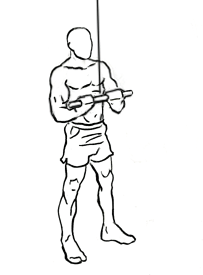
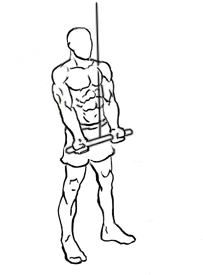
Exercise images by Everkinetic.




